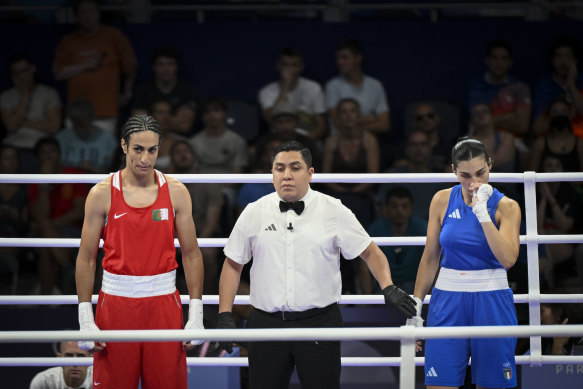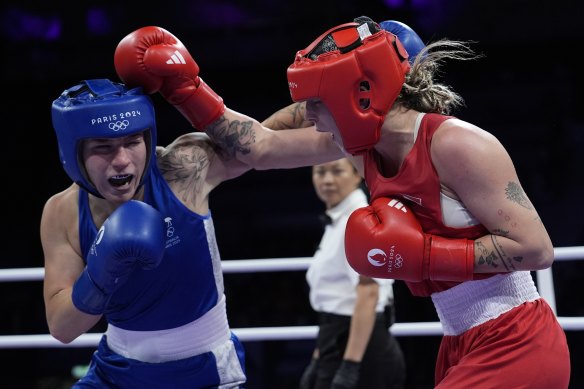This was published 7 months ago
Opinion
Even if you accept that gender is fluid, the rules of sport shouldn’t be
Chip Le Grand
State political editorThe maelstrom that has engulfed Algerian boxer Imane Khelif in Paris is a wretched thing. It is humiliating for Khelif, who has always identified as a woman, and crushing for every rival boxer competing in her weight division.
And it should never have happened.

Algerian boxer Imane Khelif.Credit: Eddie Jim
Although there is a complex backstory to this saga that we will get to, the eligibility rules on gender in international boxing are refreshingly clear.
According to the International Boxing Association’s technical and competition rules, women should compete against women and men against men. They define a woman/female/girl as anyone with an XX chromosome and a man/male/boy as anyone with an XY chromosome.
It is an essential acknowledgement of sex difference in a combat sport where asking women to fight men is unfair and dangerous.
The rules also provide that, to determine eligibility, boxers are subject to random and targeted gender tests. A boxer who fails a test should be disqualified from competition and prohibited from any other competitions owned and sanctioned by the IBA.
According to the minutes of an IBA board of directors meeting in March last year, Khelif and another boxer, Lin Yu-ting from Chinese Taipei, were tested at the last two world championships.
The tests were conducted a year apart by separate, independent labs in different countries, and the results were the same – Khelif and Lin were deemed not eligible to compete as women.
Khelif was disqualified from the 2023 championship as she was preparing for her gold medal bout in Delhi.
The IBA hasn’t provided details about why Khelif failed her gender eligibility tests, other than to say it did not involve screening for testosterone levels, it took seven days for the results to be returned and Khelif lodged and then withdrew an appeal before the Court of Arbitration for Sport.
The test most likely conducted, given the IBA rules, is an analysis to determine whether the boxers carry XX or XY chromosomes, an immutable biological distinction. For reasons that are obvious, the specifics of the test and the results are confidential matters for the two athletes.
The tragedy here is that Khelif, an Algerian athlete from an impoverished background with an extraordinary personal story to tell, is now fodder in a raging culture war, with Italian Prime Minister Giorgia Meloni and author J.K. Rowling lacing up their gloves and calling out seconds.
If the IBA rules were being properly applied in Paris, neither Khelif nor Lin would be competing women at these Olympics.
So why are they? This is where it gets complicated.

Italy’s Angela Carini fights back tears at the end of her aborted fight against Algeria’s Imane Khelif.Credit: Eddie Jim
The IBA, for all its clarity about the need to keep men and women separated in a boxing ring, is a basket case when it comes to governance, financial management and combatting corruption.
In June last year, the International Olympic Federation became so frustrated at the IBA’s refusal to embrace reform that it stripped its status as the international governing body for boxing. To keep boxing at the Olympics, the IOC assumed governance responsibility for the sport at Paris 2024.
As a consequence, the gender eligibility rules for boxers in Paris are squarely in the bailiwick of the IOC.
The problem is that the IOC, at the end of a tortured, two-year process that culminated in the 2021 publication of a “Framework on Fairness, Inclusion and Non-Discrimination on the basis of Gender Identity and for Sex-Variations” declared it had no interest in setting gender eligibility rules for any sport.

Australia’s Marissa Williamson weighed into the gender storm in Paris.Credit: AP
As the IOC said in its preface to the framework: “The IOC recognised that it must be in the remit of each sport and its governing body to determine how an athlete may be at a disproportionate advantage against their peers.”
This is why swimming, athletics and cycling all moved to develop their own gender policies, which ensure that, regardless of identity, athletes who have gone through male puberty can’t compete as women at international level.
By contrast, the IOC framework offers only a series of well-meaning aspirations. One of them is that “no athlete should be precluded from competing or excluded from competition on the exclusive ground of an unverified, alleged or perceived unfair competitive advantage due to their sex variations, physical appearance and/or transgender status”.
Try telling that to Angela Carini, the Italian boxer who withdrew from her bout against Khelif on Thursday, after just 46 seconds, in tears. Try telling it to Hungary’s Anna Luca Hamori, who fights Khelif next.
The IOC, having sleepwalked its Olympic boxing competition into this hot mess, is now seeking to convince us the rules of the sport are being diligently followed.
Everyone in boxing knows this is not true. And everyone who understands sport knows it is not fair.
For Olympics news, results and expert analysis sent daily throughout the Games, sign up for our Sport newsletter.